Yaw Control
Similar to Limited Slip Differential, this controls the distribution of torque to the left and right side wheels. Helps cars reduce understeer and gives a faster turning ability.
If Yaw Control is set too high there is even a risk of creating too much oversteer, and increases tire wear significantly. Although, if yaw is adjusted properly, the car's turn in ability is tremendous. Adjusting yaw control is a compromise depending on track layout. Yaw is not controllable from F1 cockpit.
This is a very simple explanation, and not very clear one.
To make explanation more understandable, I find a great article on net. Explanation is about yaw and how to control yaw in NASCAR environment and specific car construction.
Article is from Stockcarscience website, and I want to thank them to allow me to use it.
Why Jeff Gordon is Jealous of
Carl Edwards' Yaw
Apparently, Jeff Gordon has a slight case of yaw envy. David Newton reports on ESPN.com that Gordon asked NASCAR to take a look at the No. 99 car of Carl Edwards because he thinks that yaw is the reason Carl's been so competitive this season.
You may have learned that it takes three numbers to uniquely locate an object in space: For example, right now I'm in Los Angeles at the corner of Hope and 8th Streets and I'm on the 11th floor.
The limitation of this description is that it only identifies a point. I (like a car) have spatial extent. I could be lying down or standing up, and the three points I just specified don't tell you anything about how I'm oriented, only where I'm located. We have to specify the angles the car makes with respect to three axes, which we call the x-axis, y-axis and z-axis. In vehicle dynamics, the x axis is along the length of the car, the y-axis is crosswise, pointing toward the driver's right, and the z axis points downward, as I've drawn below. (Engineers take the z-axis to be positive in the downward direction.)
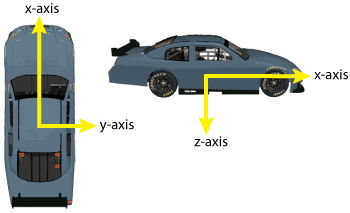
Yaw describes the rotation of the car about the z-axis. The yaw angle is the angle between a line pointing in the direction the car is moving and the car's x-axis (which is the direction the car is pointed). In the simplest case (shown on the left side of the drawing below), the car is traveling straight and is pointed in exactly the same direction it is traveling, so it has no yaw. The car on the right is yawed, which means that the car is headed in a different direction than it is pointing.
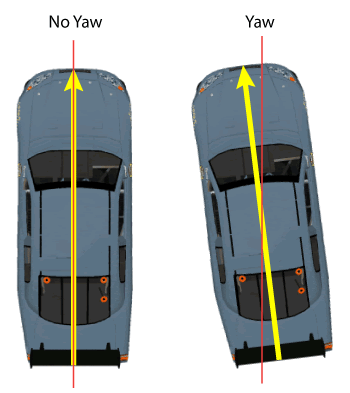
A car by definition is yawed when it corners because it is pointing in a different direction than it is moving at every point along the turn. Yaw is important because air hits the car differently when the car is at an angle to the oncoming air compared to when it is hitting the air head on, as shown below. In effect, the car on the right has a head start on the turn because it is yawed before it enters the turn. Yaw puts the car in a position so that the air helps the car turn.
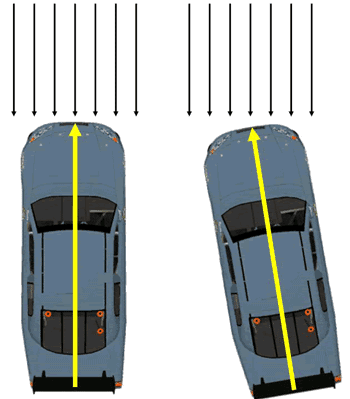
A number of people have noticed that some cars seem look yawed heading down the straightaway. They appear to have an inherent yaw built into them. Darlington has nice straightaways, which is why yaw has been in the news this week.
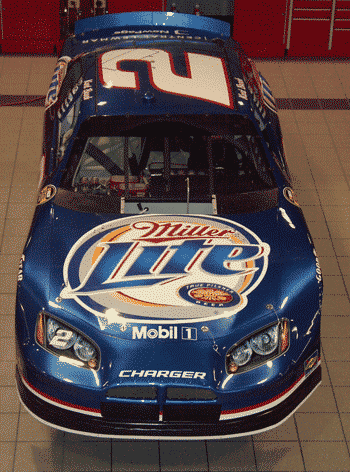 Let's review some history. The old cars were asymmetric-literally kidney-bean shaped-as shown below. Compare how much of the left fender (on the right side of the picture) you can see relative to the right fender. Gary Nelson, the founding director of the NASCAR Research and Development Center said once that the cars were so misshaped that they looked like they had been in an accident before they even got on the track.
Let's review some history. The old cars were asymmetric-literally kidney-bean shaped-as shown below. Compare how much of the left fender (on the right side of the picture) you can see relative to the right fender. Gary Nelson, the founding director of the NASCAR Research and Development Center said once that the cars were so misshaped that they looked like they had been in an accident before they even got on the track.
All of this body manipulation was for aerodynamic advantage; however, the research that goes into figuring out exactly how to optimize bodies, as well as the cost of cutting off and replacing bodies, was getting out of hand. This was one NASCAR's major motivations in introducing the new car.
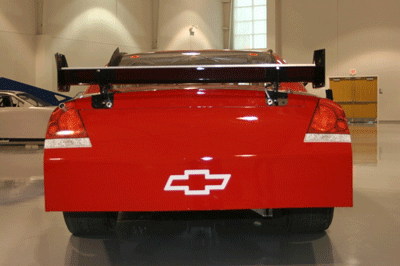 Compare the old car with the new car in the drawing showing yaw. There still is some built-in asymmetry in the new car: Note how the wing isn't exactly centered between the two taillight decals (check mounting points), for example. The left rear quarter panel is much more tapered than the right rear quarter panel; however, the amount of asymmetry is pretty much fixed by the NASCAR body templates.
Compare the old car with the new car in the drawing showing yaw. There still is some built-in asymmetry in the new car: Note how the wing isn't exactly centered between the two taillight decals (check mounting points), for example. The left rear quarter panel is much more tapered than the right rear quarter panel; however, the amount of asymmetry is pretty much fixed by the NASCAR body templates.
Of all the drivers, Jeff Gordon knows that you don't mess with the new car's body. He has complained that something is more amiss than it should be with the rear end gear on the No. 99, causing it to have yaw and thus giving it the same type of asymmetry the new car's fixed body shape was meant to eliminate.
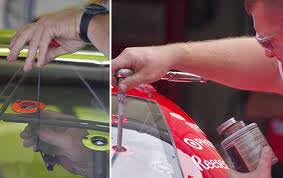 NASCAR cars have a solid rear axle. The rear end gear links the driveshaft to the rear wheels. There are three holes in the rear windshield: Two of those are for adjusting the springs on either side of the car. The third (the bottom one on the right) is for adjusting the trackbar. The trackbar shifts the rear end gear to the left or the right, as I've illustrated in the drawing below. I've exaggerated the shifts-if I drew them to scale, you wouldn't be able to see them. The leftmost drawing is a car with no offset in the rear end gear. Note how the front and rear wheels are lined up. The rear wheels would follow right in the front wheels' tracks. The middle drawing shows a car with the rear end gear shifted to the right and the rightmost picture shows that a car with such a shift will be yawed.
NASCAR cars have a solid rear axle. The rear end gear links the driveshaft to the rear wheels. There are three holes in the rear windshield: Two of those are for adjusting the springs on either side of the car. The third (the bottom one on the right) is for adjusting the trackbar. The trackbar shifts the rear end gear to the left or the right, as I've illustrated in the drawing below. I've exaggerated the shifts-if I drew them to scale, you wouldn't be able to see them. The leftmost drawing is a car with no offset in the rear end gear. Note how the front and rear wheels are lined up. The rear wheels would follow right in the front wheels' tracks. The middle drawing shows a car with the rear end gear shifted to the right and the rightmost picture shows that a car with such a shift will be yawed.
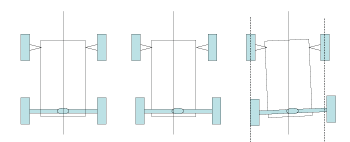
Kyle Busch referred to the way Edwards' car moves as it looks "stupid going down the straightaway because it's dog-tracking." (ESPN). A running dog is usually a little sideways. The rear paws never follow in the front paw prints. It's also sometimes called crabbing, and refers to the situation shown above: the rear wheels do not follow straight behind the front ones.
The situation with some cars is so extreme, that Gordon said:
"When cars can't even get on the scales because they're running sideways, it's something they need to address." (ESPN)
The scales used during inspection are four plates (two in front, two in the rear), that are in line with each other. Jeff is suggesting that the offset between the front and the rear wheels is so great that some cars have trouble getting onto the scales.
It's ironic that Gordon is complaining about this, as Hendrick Motorsports was one of the first teams to experiment with introducing yaw using the suspension. One possible motivation for Gordon's comments is that he is of the opinion that Roush Fenway Racing is headed down the same slippery slope as coil binding: The engineers are modifying the car in way that makes it much more difficult to drive.
Almost every team has tried to duplicate what Edwards has, but not every driver can handle it. "It makes the cars drive so terrible that it doesn't really help us in any way that we really need it," Gordon said. (ESPN)
There are rules about how much you can move the trackbar, so there are obviously other things being done to induce yaw in the car. One possibility: The wheelbase (the distance between the front and rear wheels) can be 110" plus or minus 1/2". If you make the wheelbase 109.5" on the left side and 110.5" on the right side, you've gained an inch of asymmetry. There are a number of other places where you can make little changes and, when all the little changes are considered, they add up to a significant effect.
I noted early on in the introduction of the new car that it was only a matter of time before the very clever people working at race shops would come up with ways to get around the new NASCAR-imposed limitations. One consequence of this type of offset is that the cars are drifting, much like they do on dirt tracks. It should be no surprise then, that someone like Edwards, who still does a lot of dirt track racing, is comfortable driving a car set up like this. That's one rationale to account for why Edwards, who really struggled with the new car last year, is doing so well this year. As with coil binding, some teams have figured out how to get yaw and others are a little behind on the curve. Some drivers caught on to how to drive a coil-bound car a lot faster than others. The question that remains is whether there are other ways to get the car to turn better that would be more comfortable for the drivers who aren't comfortable driving horizontally down the straightaways.






